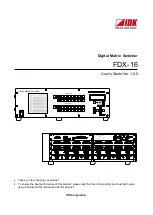
xStack
®
DGS-3400 Series Layer 2 Gigabit Ethernet Managed Switch
21
links is down. Once the device has been removed, the remaining switches will update their stacking topology database to reflect
the change. Any one of the three roles, Primary Master, Backup Master or Slave, may be removed from the stack, yet different
processes occur for each specific device removal.
If a Slave device has been removed, the Primary Master will inform other switches of the hot remove of this device through the
use of unit leave messages. Switches in the stack will clear the configurations of the unit removed, and dynamically learned
databases, such as ARP, will be cleared as well.
If the Backup Master has been hot removed, a new Backup Master will be chosen through the election process previously
described. Switches in the stack will clear the configurations of the unit removed, and dynamically learned databases, such as
ARP, will be cleared as well. Then the Backup Master will begin backing up the Primary Master when the database
synchronization has been completed by the stack.
If the Primary Master is removed, the Backup Master will assume the Primary Master’s role and a new Backup Master will be
chosen using the election process. Switches in the stack will clear the configurations of the unit removed, and dynamically learned
databases, such as ARP, will be cleared as well. The new Primary Master will inherit the MAC and IP address of the previous
Primary Master to avoid conflict within the stack and the network itself.
If both the Primary Master and the Backup Master are removed, the election process is immediately processed and a new Primary
Master and Backup Master are determined. Switches in the stack will clear the configurations of the units removed, and
dynamically learned databases, such as ARP, will be cleared as well. Static switch configurations still remain in the database of
the remaining switches in the stack and those functions will not be affected.
NOTE:
If there is a Box ID conflict when the stack is in the discovery phase, the device
will enter a special standalone topology mode. Users can only get device information,
configure Box IDs, save and reboot. All stacking ports will be disabled and an error
message will be produced on the local console port of each device in the stack. Users
must reconfigure Box IDs and reboot the stack.
Stacking Mode Settings
To begin the stacking process, users must first enable this device for stacking by using the Stacking Mode Settings window.
To view this window, click
Administration
>
Stacking > Mode Settings
, as shown below:
Figure 2 - 11 Stacking Mode Settings window
Use the pull-down menu, choose
Enabled
and click
Apply
to allow stacking of this Switch.
Box Information
This window is used to configure stacking parameters associated with all switches in the xStack
®
DGS-3400 Series. The user may
configure parameters such as box ID, box priority and pre-assigning model names to switches to be entered into the switch stack.
To view this window, click
Administration
>
Stacking
>
Box Information
, as shown below:
Содержание xStack
Страница 109: ...xStack DGS 3400 Series Layer 2 Gigabit Ethernet Managed Switch 98 Figure 2 106 Port Speed Utilizing the Tool Tip...
Страница 293: ...xStack DGS 3400 Series Layer 2 Gigabit Ethernet Managed Switch 282 Figure 6 69 JWAC Global State Configuration window...
Страница 339: ...xStack DGS 3400 Series Layer 2 Gigabit Ethernet Managed Switch 328...
















































